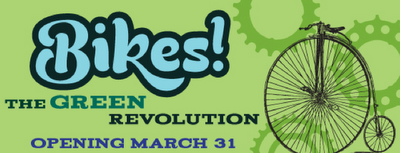We have been excited about the exhibit since since early in the winter when Martha Williams, who is the great photographer behind Bike Fancy (link on our sidebar), let us know she was working with the museum by sharing some of her photographs with the curators.
How great, because we love the way that Martha pictures bike life here in Chicago and hoped the infectious feeling of her blog would infuse the exhibit. Seems this might be the case as the guys at Grid got a sneak peek and much of Martha's work is included. Looks like the exhibit should be great fun.
Click to the sidebar on the Grid Network for their take. Know that a kid at the exhibit will not be a transportation journalist and may have a totally different take on the exhibit, of course! If your read us much you know that we have already covered the ride to the museum. Don't forget extra clothes for anyone who might spend time in the river and waterways exhibit! Splash!
The Notebaert Website
Looking at what else is going on at the museum might color which day a family might choose to visit! Thursdays, Fridays, Saturdays and Sundays have plenty of excitement at the Notebeart these days. If you are hoping to avoid a crowd other days might be good....
Thursdays are free for Illinois residents! Hooray.
Fridays and Saturdays feature nature movies for kids from the International Children's Film Fest (you'll need tickets):
Weekday Screenings at 9:45 & 11:45 a.m. Friday April 13Weekend Screenings at 10:30 a.m., 11:30 a.m., 12:30 p.m. & 1:30 p.m. April 28, May 12, June 16, July 21 & August 25
Sundays during the exhibit, a cute bike drop in is happening called "Garnish your Gears," and Green City Market is in residence (until the farmers give up on being inside while the weather is so good). The market could take care of the snacks ($$$) and there are always great snacks — but bring cash!
Rumor has it that Kidical Mass is hoping to do a ride along to the museum but you need to check the Chicago Kidical Mass page to check up on that.
Recopied below are our food and bathroom tips from last winter along with favorite routes.
Happy April!
Routes and Suggestions for Eating, Coffee etc. from our older posts:
From Humboldt Park or Logan Square going west I try to take little streets and eventually reach Belden or Webster streets going east. From Bucktown I follow Cortland or Webster and go north on Racine to Belden, which is quiet and all stop signs and lights from just west of De Paul all the way to the lake. Once at the Lake just turn north and coast up to the Nature Museum. The Belmont bus also runs east with room for two bikes or as many people as you can fit, and it stops right in front of the museum.
From the West Loop I would take Peoria to Lake, cut along Wacker by the river on the sidewalk, and then go north on Wabash all the way to the Gold Coast. I cut east to State from Wabash as it disappears just by the Sofitel, then walk / ride State or the sidewalk on Astor or Lakeshore through the Gold Coast to Lincoln Park. I ride in the park past the zoo and up to Fullerton and the Nature Museum. This route is mostly a quiet path through a busy area.
There are lots of good places for an emergency bathroom stop heading both east and north on these rides and of course the museum has plenty of bathrooms.
 |
Goodies at Bake.
Bake is good but hard to see
without a big sign. It's on the north
side of North Ave near the Handlebar.
|
Coming from the west, we stop early in the ride at Bake on 2246 W North Ave, Floriole Bakery on 1220 W Webster, a quick jog from Belden, or Sweet Mandy B’s next door. Coming from the north, Bittersweet Bakery is at 1114 W Belmont. Baked goods and hot chocolate are great there but Kickstand Coffee has better coffee if you must have it. It’s a crowded trafficy ride east to Kickstand from Bittersweet for about seven blocks. I wouldn't take Belmont the whole way east to the museum - a side street would be better. Not sure which.
The Red Hen Bakery on 500 W Diversey (just north of the park/museum and about two blocks west of the giant Goethe statue) does breakfast, coffee and sandwiches. North Pond Cafe has fancy brunch on Sundays but it’s too fancy for kids!
These places take care of a morning treat, but for later I’d pack lunch and a snack too. Bike parking is good at the Museum or along the park that surrounds it. You can bring your unsorted recycling to the bin out front. Don’t forget to bring some crumbs for the ducks and geese and walk around North Pond, which has one of the best views of the city and a playground. What could be more fun?
You'll see us there!









































